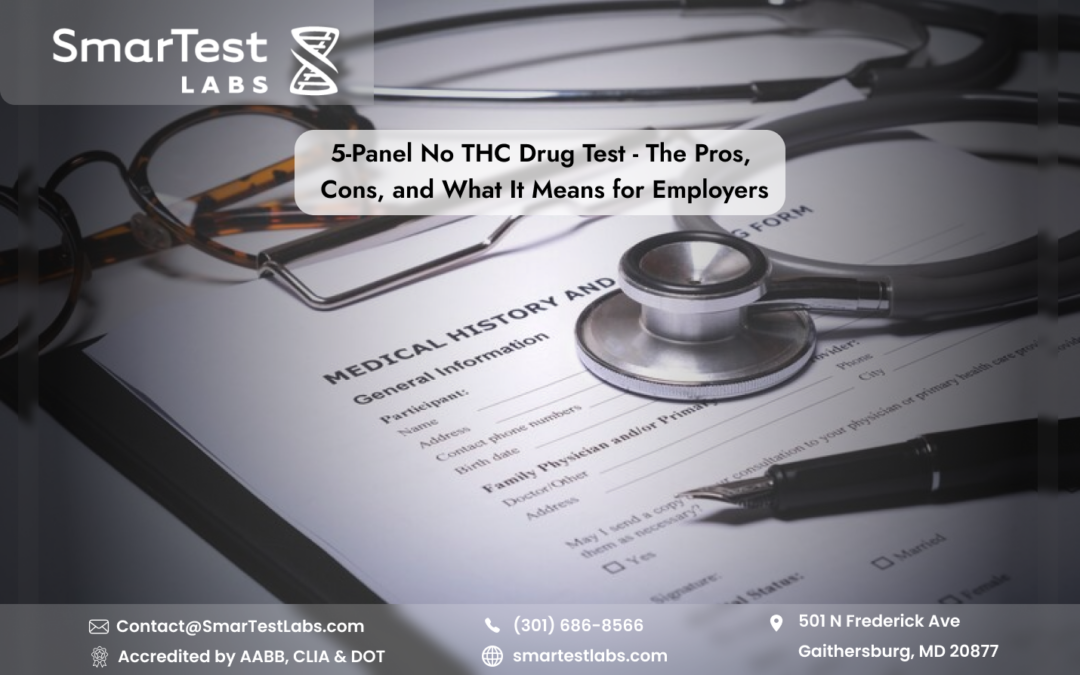What is a 5-panel Drug Test
A 5-Panel drug these, analyzes 5 basic drugs that are in a person’s system. The test as a screening method designed to test for five specific drugs. The drugs tested are marijuana (THC), heroine, morphine, codeine, Amphetamines and phencyclidine (PCP). The test is done for various reasons, ranging from pre-employment, reasonable suspicion, random testing, individual testing, post-accident and many other reasons. It is a very simple test that can provide accurate results.
The test can be done using many biological samples like urine, hair and saliva. Each of these samples have different retention timeframes of the drugs. Hence, the test requirements are what drives the kind of sample used.
Why do employers require drug tests
5-panel Drug testing was initiated by the Department of Transportation (DOT) in 1980 as a standard for drug testing for companies whose employees perform safety sensitive jobs. A 5-panel drug test has become an industry standard for Department of Transport and other safety sensitive duty organizations.
Drug Testing helps employers keep a productive and safe working environment. In many ways it assists assist employers help employees with their addiction and provide them assistance for recovery.
Substances that can be detected in a 5-panel drug test
A 5-panel drug test can detect Marijuana (THC- tetrahydrocannabinol) or it can omit THC from the test depending on the request that is made. There are a few ways to test the sample from the person. It can either be done using a person’s urine, hair or saliva.
Marijuana (THC)
If THC is part of the test, it can detect the presence or absence of
THC in a person’s urine for up to 3 days – 30 days (heavy users).
- Urine – THC detection time is 3 – 30 days in urine.
- Hair – THC remains in hair for up to 9- days.
- Saliva – THC remains in saliva for up to 72 hours.
With a few regulatory changes, there are times when THC is omitted from a 5-panel test
Opiates
Opiates (heroine, codeine morphine) are used commonly for pain relief. These drug detection times are as follows:
- Urine – Detection time is 3 – 4 days
- Saliva – Detection time is 1 – 4 days
- Hair – Detection time is 90 days.
Amphetamines
Although this is used for treatment of certain conditions like ADHD, they are often abused.
- Urine Test: Detection time is 1-3 days after use.
- Saliva Test: Detection time is up to 1-4 days.
- Hair Test: Detection time is up to 90 days.
-
Cocaine
Cocaine which is found in many biological mediums is a highly addictive drug.
- Urine Test:Detection time is up to 3 days after use.
- Saliva Test: Detection time is up to 24-48 hours.
- Hair Test: Detection time is up to 90 days.
-
Phencyclidine (PCP)
PCP, is a drug that can cause dizziness, hallucination and other severe
- Urine Test: Detection time is up to 8 days
- Saliva Test: Detection time is up to 1-3 days.
- Hair Test: Detection time is up to 90 days.
What are the Pros and Cons of No-THC Testing
There are positive and negative risks to managing drug testing.
Pros
- Testing provides organizations the ability to be compliant with regulations. Employers with safety sensitive duties must be compliant with either the Department of Transportation regulations or their safety policies.
- Defining exactly what kind of drug testing is required generates consistency with the policies of the organization. There should be no confusion what is required as results of the test. Defining a no THC policy sends the organization a message that no one should be found impaired by THC.
- Having and maintaining a drug free culture is important for employers as it reduces potential risks of injury and litigation. It creates a safe workplace and increases productivity in employees.
Cons
- Using THC has become common as a medical necessity in many cases. Having to single out individuals as to be cautiously done as checks need to be conducted to verify the integrity and use of THC for medical reasons. However, companies that have a no-THC policy can enforce the policy as they wish but still need to consider medical needs of the individuals.
- Having a zero tolerance to THC can potentially eliminate candidates who have valid reasons for the use of THC.
- There is a potential, in the event of the sample being contaminated, it could provide erroneous results. This is turn could cause mistakes in decisions like terminations and other human resource issues.
- Balancing a no THC policy is tricky and must be well thought through especially since there are currently regulations that allow for use of medical required THC.
The use of other drugs listed above are most often not approved in organizations. These are much more potent drugs and can cause severe consequences to the user of the drug and the safety and productivity of the organization.
At SmarTest Labs, we provide you the appropriate guidance in implementing your drug safety policy, enforcement and testing procedures. We adopt a chain of custody, and our testers are trained and qualified. We are a CLIA certified laboratory.
Call us at: 301-686-8566 (or)
Email: contact@smartestlabs.com

Recent Comments